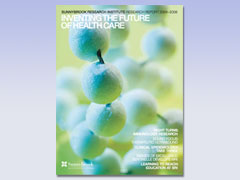Purple Protagonists
What can purple sea urchins tell us about the evolution of human immunity? A lot, it turns out. After a century of provoking questions as experimental subjects for developmental biologists, the spiny, tiny, globular sea animals are rousing interest in immunologists and have pricked a hole in prevailing work on the origin of human adaptive immunity.
A hallmark of the human immune response is diversity. Our immune system's ability to recognize and respond to antigens — a unique aspect of jawed vertebrates (animals with a backbone or spine) — depends on a process of gene rearrangement called V(D)J recombination. Scientists have known for years that the Rag1 and Rag2 proteins mediate this process. What has puzzled them is how it got started in jawed vertebrates like us.
As no significantly Rag-like genes had been discovered in sea urchins or other invertebrates, evolutionary biologists hypothesized that V(D)J recombination began when the Rag genes were co-opted after horizontal gene transfer and clustered together in a common jawed vertebrate ancestor — a kind of immunological big bang. Proponents of intelligent design pointed to V(D)J recombination as an example of something that suddenly appeared and couldn't be explained by evolution. While the former had more credibility, both explanations appear to be wrong, based on a discovery made by Jonathan Rast in the sea urchin.
Rast, a scientist in molecular and cellular biology at Sunnybrook Research Institute, found Rag1- and Rag2-like genes in the sea urchin genome and provided compelling evidence that they are homologues of vertebrate Rag1/2, meaning they share an evolutionary origin with them. "We were really surprised to find the Rag1/2-like cluster," says Rast, "especially since nothing similar had been found in the sequenced genome of the sea squirt, which is closer to us evolutionarily."
As more animal genomes are sequenced, scientists are finding that gene loss can explain the absence of a gene or sequence in an organism that is an intermediate between two in which they do appear. Rast says, "It's another case where, with an incomplete data set, it looks like something just popped into being, but as you get more information, you realize that it's much more ancient than previously thought."
Comparing the sea urchin Rag1/2-like genes with vertebrate Rag1/2, Rast and graduate student Cynthia Messier built a persuasive case: both sets of genes share similarities in sequence and genomic organization and are coexpressed during development and in adult tissues. A collaborator in the United States was able to show that the sea urchin genes interact with each other and with Rag1/2 proteins from several vertebrates.
As well as undermining prevailing theories on the origin of V(D)J recombination, Rast's work has implications for understanding it and other aspects of adaptive immunity in humans. "This finding and other discoveries about the sea urchin immune system offer experimental opportunities that we didn't have before," says Rast. In complex vertebrates like us, it is relatively difficult to characterize regulatory interactions. But by comparing that system to what's going on in a much simpler 1,500-cell organism like the sea urchin larva, scientists can parse out which elements of the system matter most.
Perhaps even more importantly, this discovery was only part of a larger screen of the sea urchin genome in which Rast's lab found other crucial similarities with vertebrates. They can now exploit these findings to see how other immune genes are controlled in urchins. "People say, 'This gene causes leukemia,' or 'This gene causes these cells to become lymphocytes,'" says Rast. "But we know that genes don't do anything alone. They act as part of a larger program. And to understand how genes work, we've got to look at them globally."
This work was funded by the Canada Foundation for Innovation, Canadian Institutes of Health Research, Ontario Innovation Trust, National Science and Engineering Research Council, and SRI.
PDF / View full media release »





